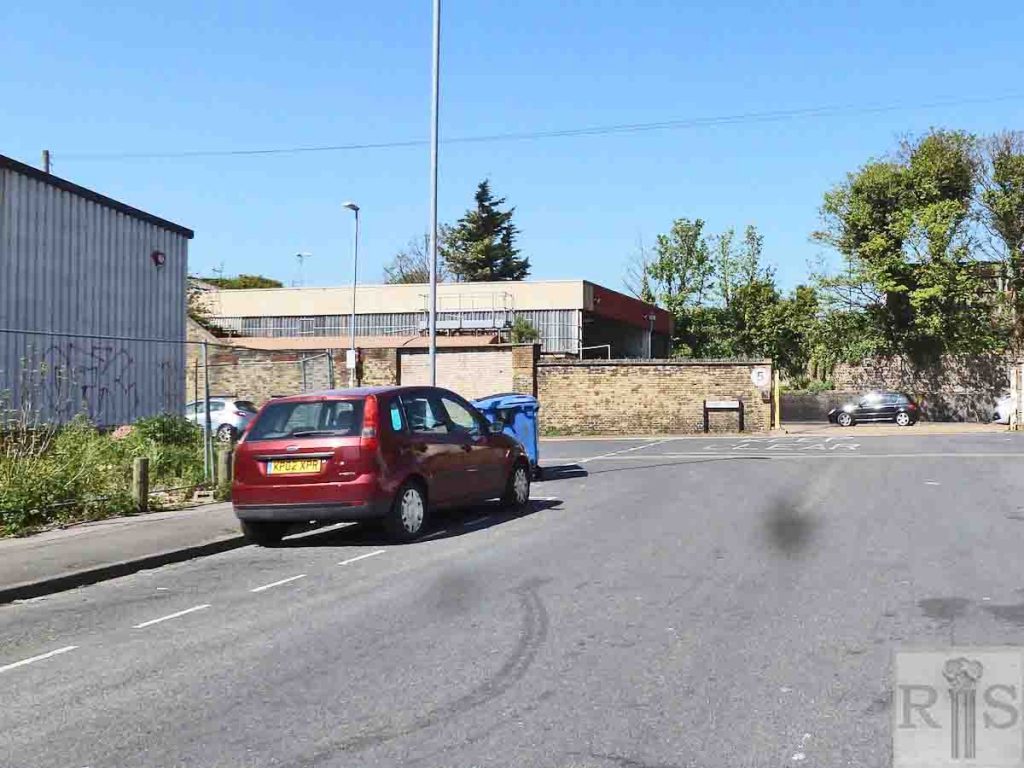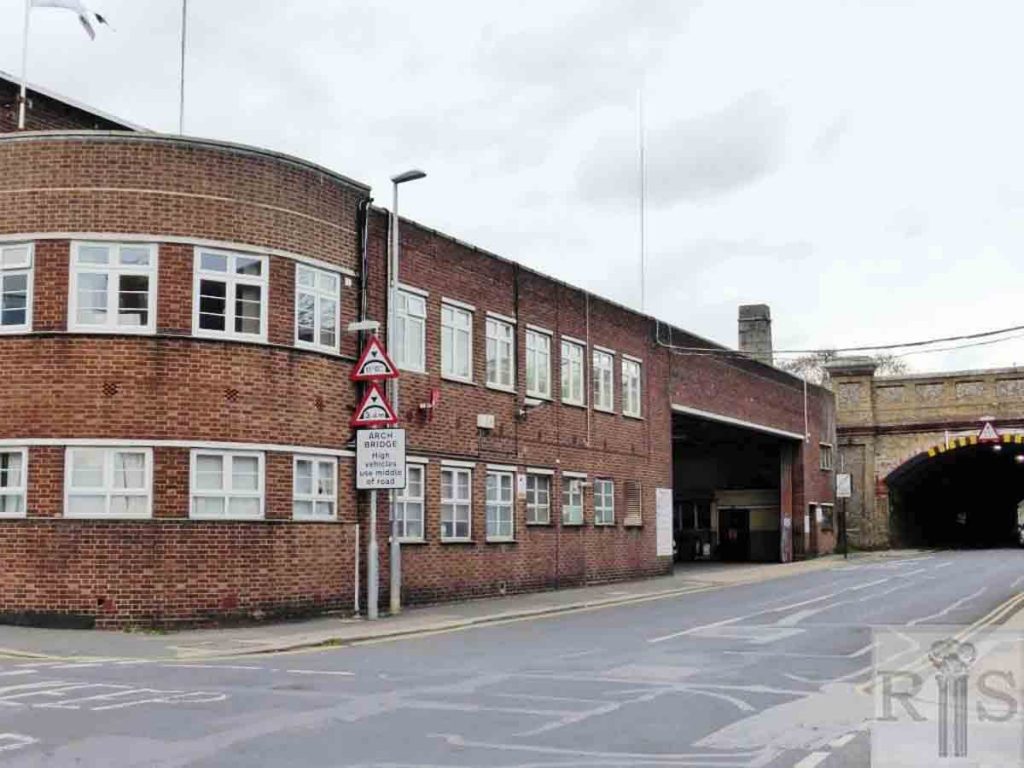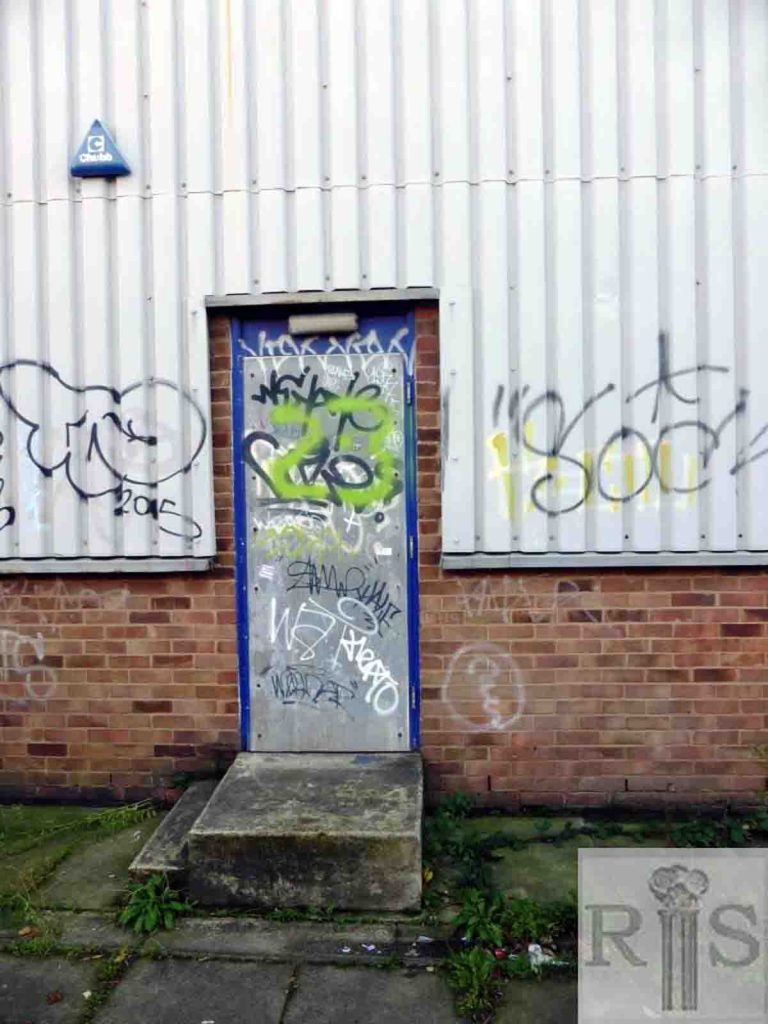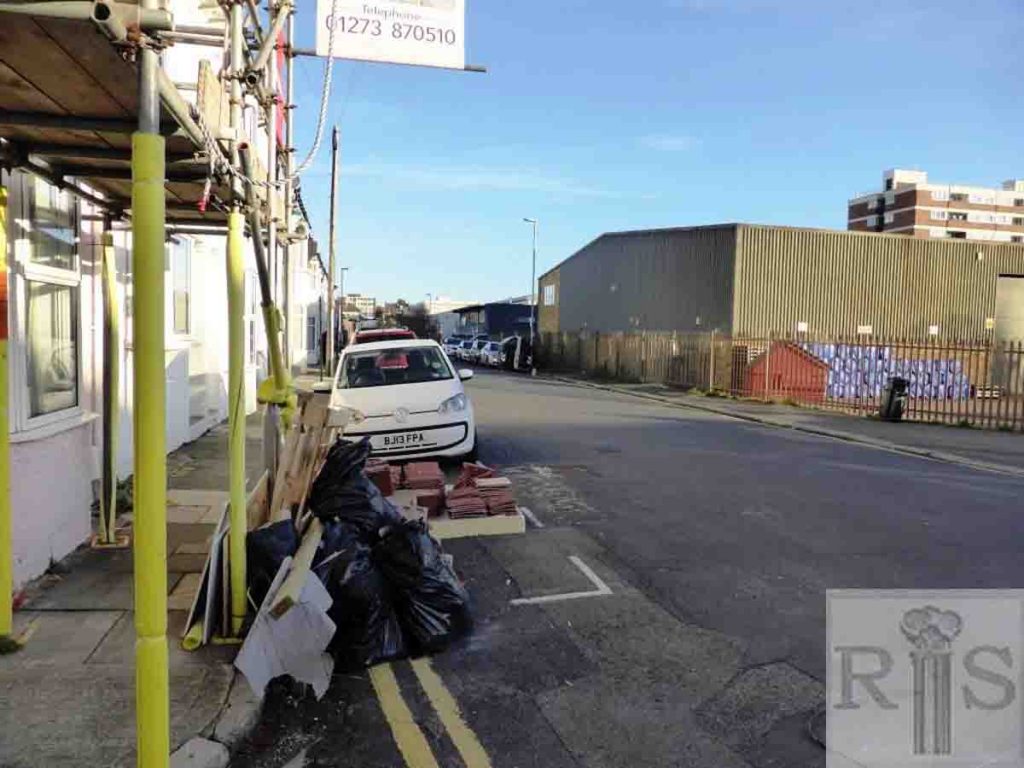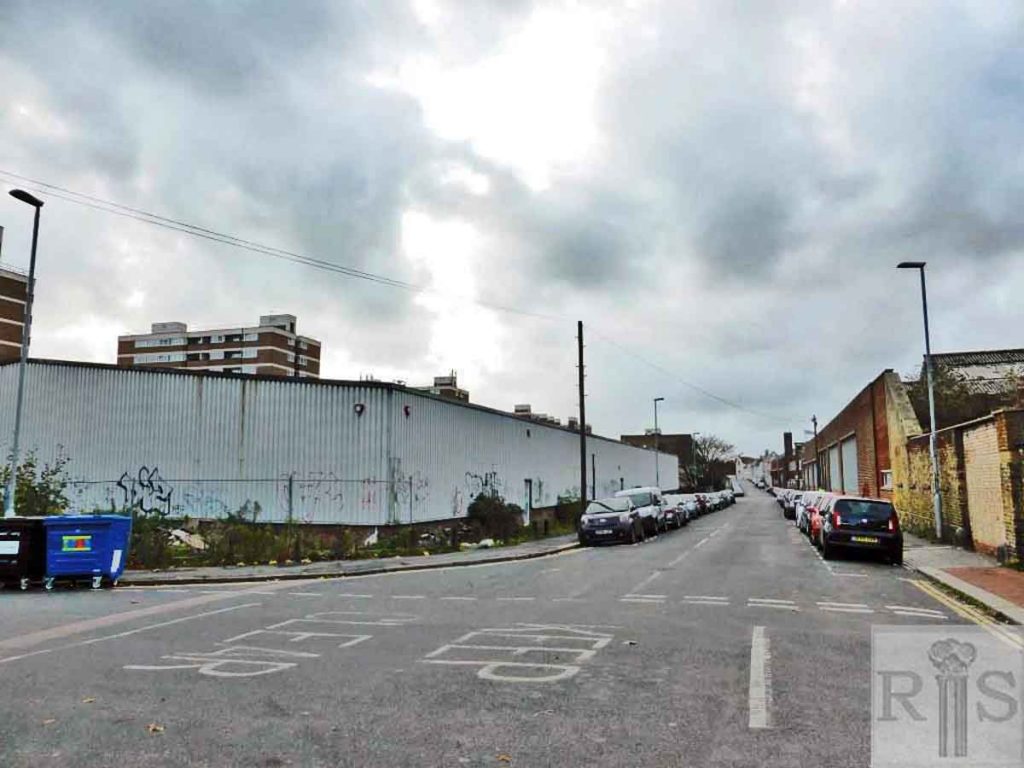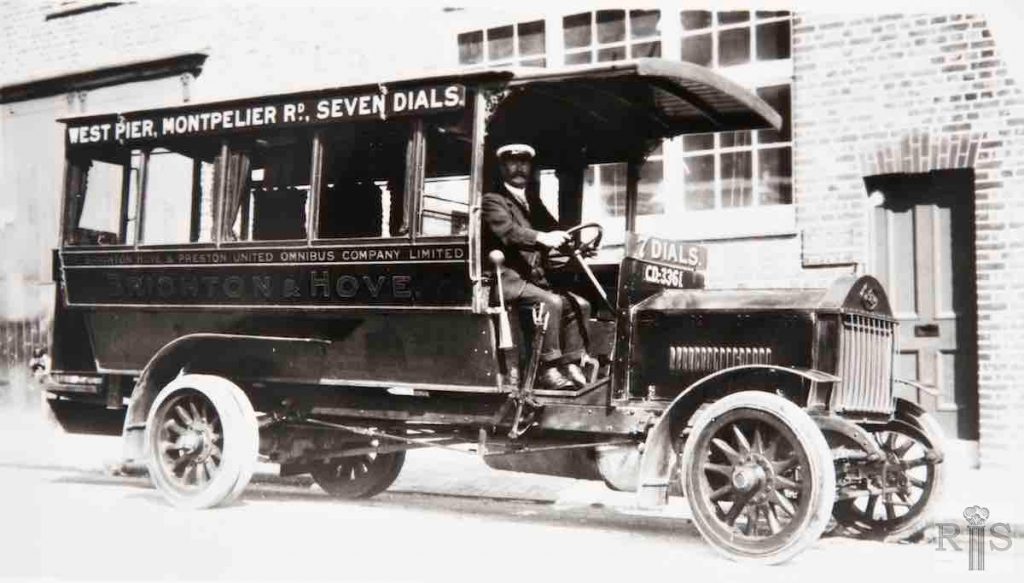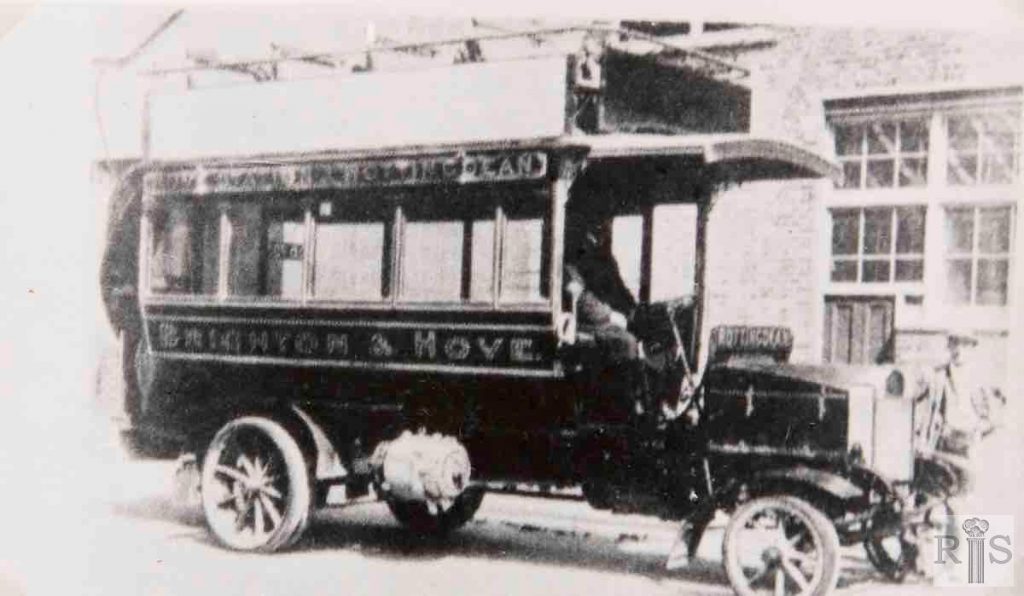
James Gray: When George Gallard began to develop the Drove Area of the Stanford Estate in the mid-1870s one of the first buildings to be erected was this large maltings. Chapman & Co., who also owned the Black Lion Brewery, opened it in 1877. It changed hands many times, the last owners being Brickwood’s Breweries. Demolition had started when these photographs were taken on 2 April 1968. jgc_14_075 and jgc_14_076
James Gray: The reverse view from the north, adjoining Hove Station. The buildings were demolished and cleared away within a few days of the date of the photographs, 22 April 1968. jgc_14_077
2018: This is a view of the former Chapman’s Maltings site from the north and looking towards the west.
James Gray: On the Conway Street frontage used to be two houses immediately adjoining the brewery and probably built for employees. Then a small coachworks. Where the bus garage now is was a small field open to the street, on which fairs were held in the autumn months. The garage was built on this field in 1930. jgc_14_078
James Gray: Looking across the cleared area from Ethel Street to Chapman’s Maltings, on the north side of Conway Street, on 3 January 1968, before any of the demolition had started. jgc_14_079
2018: In the corresponding photo taken in 1968 the Chapman’s Maltings was still intact but the buildings directly opposite had been demolished.
James Gray: Looking up Goldstone Street to the Railway Arch, in 1938. These buildings, numbered 26 – 36, were probably built about 1879, in which year this long but narrow arch was constructed and the road was carried through to Goldstone Farm. Later in 1938 all these buildings were removed for an extension to the existing omnibus garage in Conway Street. jgc_14_084
James Gray: The view westwards along Conway Street, from opposite Ellen Place, in the same year, 1938, and before the garage was extended east to the corner of Goldstone Street. Many years ago the stables of the old horse Bus Company were here, and the premises were gradually converted to a garage as Motor buses replaced the horses. jgc_14_085
2018: The houses on the south side of Conway Street (on the left in the original photo) have gone.
James Gray: Ellen Street School, in 1973. Opened on 13 October 1879, it was closed in 1974 when the new school in Elm Drive was opened, and was demolished in 1975. jgc_14_087
2018: Ellen Street School has gone, finally closed in July 1974. Between 1958 and 1974 it was called Goldstone Junior School.
James Gray: Here are two photographs of the same premises, 22 Conway Street. The house, for that is what it was, was built about 1878 and about 1890 Mr W J Holden started his blacksmiths business here, which has endured ever since, to the present day. His son is seen in both photographs. In this view, taken in 1912, he is seen as a youth of 18. jgc_14_089
2018: The blacksmith’s premises at 22 Conway Street has gone. In its place is the rear of a commercial unit: Essential Hygiene and Catering Supplies Ltd. (Photographer: Alison Minns)
James Gray: In 1960 Hove Corporation decided to make a comprehensive redevelopment of 5 acres between Sackville Road and Goldstone Villas. The area was to include the south side of Conway Street, the whole of Ellen Street, the north side of Clarendon Road and the intervening roads, such as Ellen Place and others.
James Gray: Walking eastwards along Ellen Street one came first to Albert Street and then Ellen Place, two short streets connecting Ellen Street with Conway Street. It is hard to think of a reason why they were built unless to provide shops on each corner site. Built about 1880 they were mostly removed in 1966-67 and the site will soon be redeveloped as Stage 2. jgc_14_099
James Gray: The beginning of the end of Ethel Street. Removal of an old building at the corner of Clarendon Road, 27 October 1963. jgc_14_102
2018: Both photographs were taken from the top of the steps leading down from Goldstone Villas to Conway Street. All the houses visible on the south (left) side of Conway Street have gone. In their place stands a low whitish building – a commercial unit currently occupied by Essential Hygiene and Catering Supplies Ltd. In the 1963 image, the original Ethel Street is the first turning on the left.
James Gray: Conway Street, between Goldstone Street and Ethel Street, 2 March 1963. These houses were built in 1876-1877 at the start of the building development between the railway and Blatchington Road. jgc_14_104
2018: All the houses shown in the 1963 photograph of the south side of Conway Street have been demolished, including the corner property, Reg and Phyllis’ transport cafe at 48 Conway Street on the corner of Goldstone Street (now Fonthill Road).
James Gray: One of the last links with old Conway Street and Ellen Street. With the clearance of the surrounding houses this old building was fully revealed to the public gaze for the first time. In its life of nearly 100 years it had been put to a variety of uses; motor engineers workshop, firewood dealers store, builders store and, during the 1914-1918 War, as St Barnabas Institute. In recent years it was occupied by Percy Vye & Co., Copper and Metal Beaters. Photographed on 11 October 1970, from Conway Street and Ethel Street respectively. jgc_14_113
James Gray: See caption for jgc_14_113 above. jgc_14_114
2018: In place of the industrial unit and on the land south of it now stands a commercial unit (currently occupied by Essential Hygiene and Catering Supplies Ltd) with vehicular access from Ellen Street.
James Gray: Four photographs taken by E W Holden of Hove on 23 July 1969. Most of these old buildings, with the exception of those on the north side of Conway Street, will be swept away as this project is completed. jgc_14_117
James Gray: Conway Street, between Goldstone Street and Ethel Street, 2 March 1963. These houses were built in 1876-1877 at the start of the building development between the railway and Blatchington Road. Roofscape view. jgc_14_105
2018: The row of houses in Conway Street has gone. In its place stands the Essential Hygiene and Catering Supplies Ltd building. The entrance is in Ellen Street and it backs onto the south side of Conway Street.
James Gray: A photograph taken by E W Holden of Hove on 23 July 1969. Most of these old buildings, with the exception of those on the north side of Conway Street, will be swept away as this project is completed. jgc_14_115
2018: The industrial building of Percy Vye & Co in Ethel Street and the homes in Conway Street have all been demolished.
James Gray: See caption for jgc_14_115 above. jgc_14_116
2018: The buildings in the original image have gone. In their place stands an industrial unit (currently occupied by Essential Hygiene and Catering Supplies Ltd).
James Gray: Walking eastwards along Ellen Street one came first to Albert Street and then Ellen Place, two short streets connecting Ellen Street with Conway Street. It is hard to think of a reason why they were built unless to provide shops on each corner site. Built about 1880 they were mostly removed in 1966-67 and the site will soon be redeveloped as Stage 2. jgc_14_098
James Gray: Single decker of the Brighton, Hove and Preston United Omnibus Company, outside the Conway Street Garage, about 1913. Its brief journey is shown, – West Pier, Montpelier Road, Seven Dials. jgc_14_083
James Gray: Petrol-electric bus, with twin electric motors carried at each side. Situation unknown, probably outside Conway Street Garage. jg_14_137
2019: All the houses on the left (south) side of Conway Street have been swept away in the redevelopment of the area in the 1960s.








